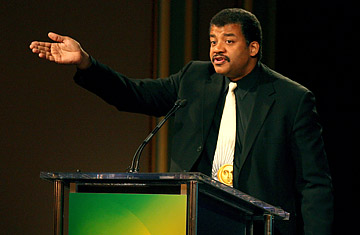
Neil deGrasse Tyson, director of New York City's Hayden Planetarium
Once a planet, now a dwarf, Pluto has lodged itself in the American consciousness for three-quarters of a century. Astrophysicist Neil deGrasse Tyson, director of New York City's Hayden Planetarium, explores the little guy's allure in his new book The Pluto Files. He talked to TIME about demoting a planet, how he became one of America's best-known scientists and how science will fare in the Obama Administration.
Why in the world do Plutophiles, which you make a pun on in your book title, even exist? What's so special about Pluto?
All Plutophiles are based in America. If you go to other countries, they have much less of an attachment to either the existence or preservation of Pluto as a planet. Once you investigate that, you find out that Disney's dog Pluto was sketched the same year the cosmic object was discovered. And Pluto was discovered by an American. So here you have a recipe for Americans falling in love with a planet that really is just a tiny ice ball. (See pictures of Mars.)
How did it get to be a planet in the first place?
There were high expectations that there was a planet of commensurate mass and size to Uranus and Neptune, orbiting behind Neptune. Scientists saw the path of Neptune around the sun, and they saw that it wasn't quite following Newton's laws of gravity. And so either Newton was wrong — though he'd been right for hundreds of years, so why assume that? — or there was some other mass out there that they hadn't cataloged yet that was influencing the motion of Neptune. So that was the famous Planet X. And eventually, Clyde Tombaugh in Arizona discovered a planet, which got named Pluto. Not by an American, though, because an American would never have named it after a highly advertised, highly marketed laxative of the same name that was popular then.
So when did we figure out that Pluto is actually pretty minuscule?
What you do is, you look at the sky chart of stars and find the day when Pluto moves to intersect the light of a star. You set up observers across the earth, and you each get a different angle of view of Pluto intersecting the light of the star. And when you do this, you can actually map the size of an object in the solar system. Here's what happened. They said, "O.K., here's a star that's going to get really close, and Pluto is surely going to blot out the light of the star." Nope. The star just went right on by untouched. "Well, here's a closer passing one." Nothing. So for every star whose light was not blocked out, Pluto got smaller and smaller and smaller. People started getting suspicious in the 1970s and started thinking of it not as the ninth planet but as one of the vagabonds of the solar system. It was smaller than Earth's moon. There are seven moons in the solar system bigger than Pluto. That doesn't bode well if you're trying to hang out in the ranks of planets. (See pictures of the Moon.)
You and your planetarium played a part in setting off this controversy. How did that come about?
We rebuilt the Hayden Planetarium between 1997 and 2000 at great expense. There was new science that needed to go in the facility, and you want the most reliable, longest-shelf-life science you can come up with. So I called in a panel of experts on the status of Pluto. And by the end of the night, it was clear that Pluto's day was over and it was time to rethink the structure and the form of the outer solar system. Our exhibit was that way for a year, and nobody complained about it until it showed up in the New York Times, Page One: "PLUTO'S NOT A PLANET? ONLY IN NEW YORK." That's when all hell broke loose and the hate mail started.
So, how much hate mail did you get?
Let me be a little more honest in the word choice there. People felt very strongly and chose sides, and most of the hate mail was in fun.
There wasn't any, "Stop talking smack about Pluto or I'm going to slash your tires"?
There were no threats of bodily harm. But there were tongue-in-cheek threats. And most of the schoolchildren were clearly disgruntled, pleading with me to put Pluto back where it belongs, as a planet.
